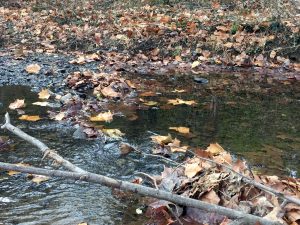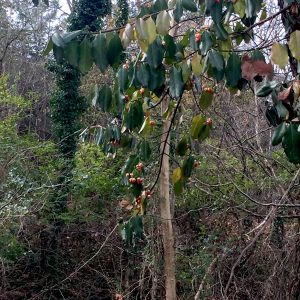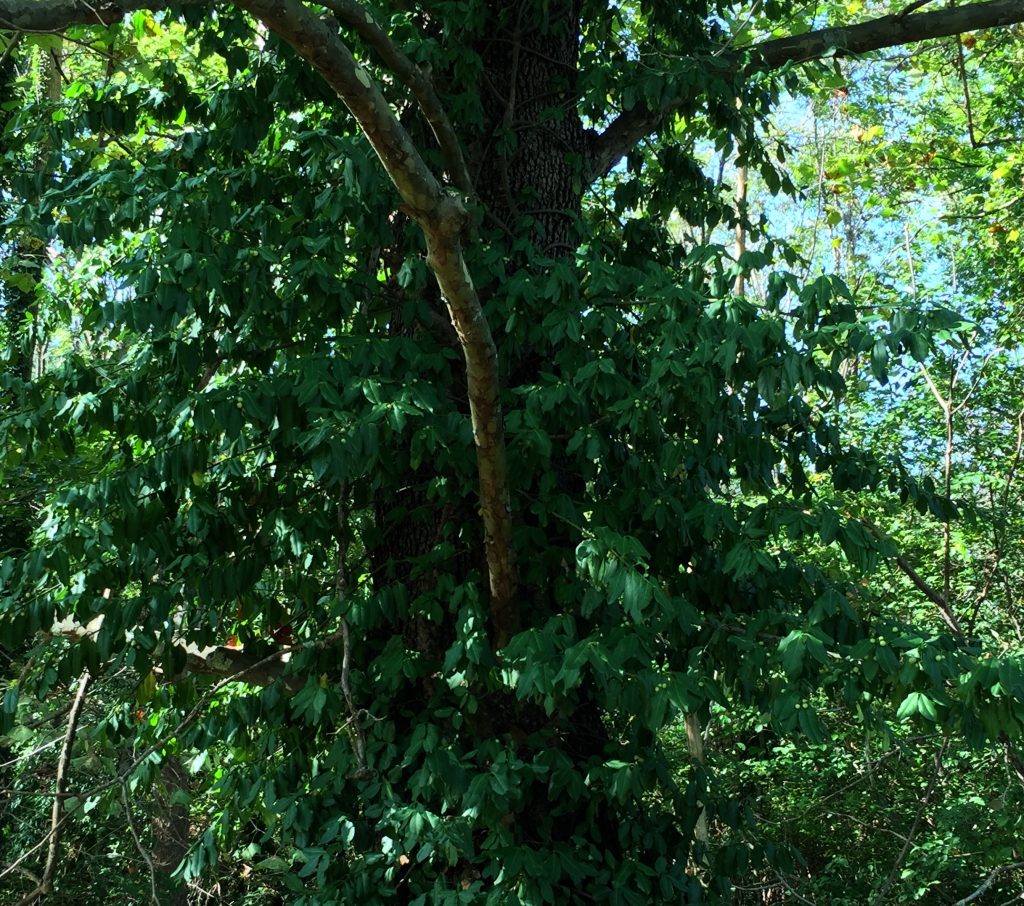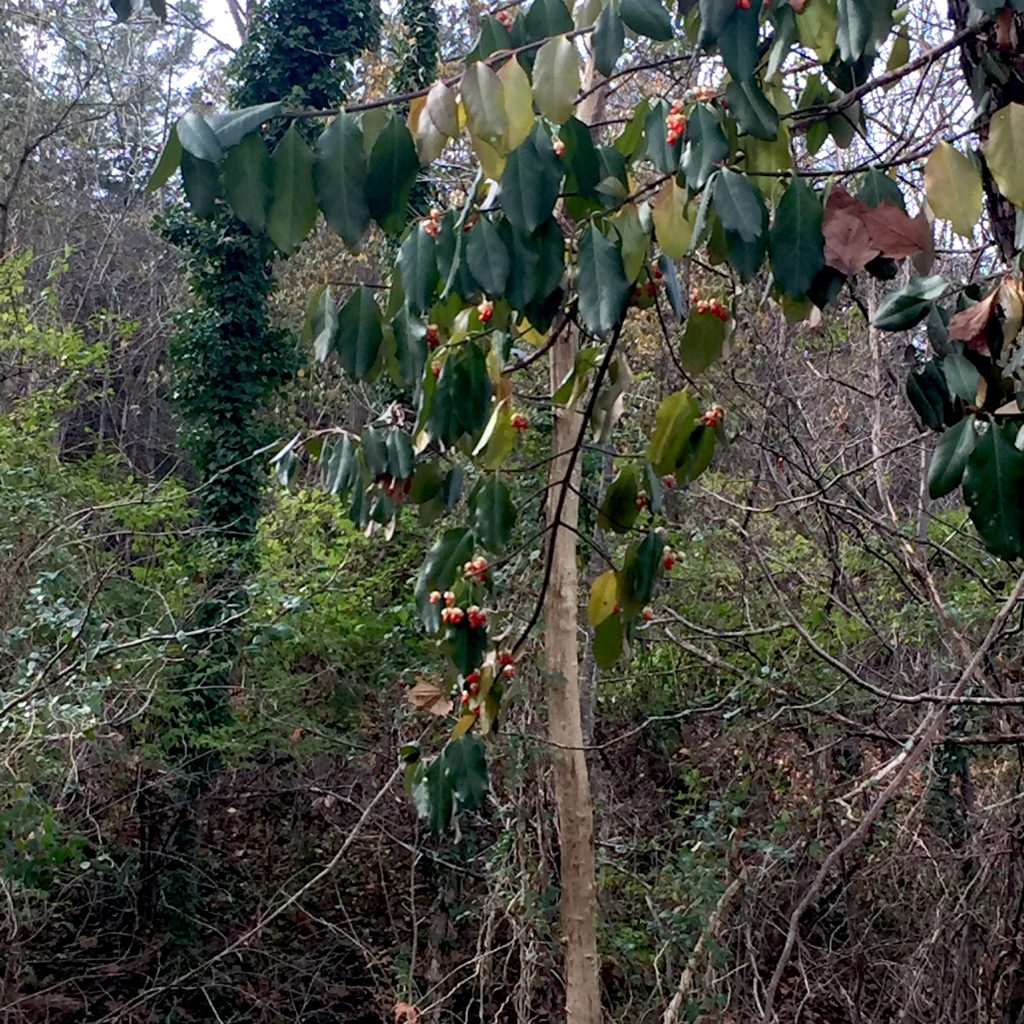18.11.19
10:30 AM
46° F, rain.
Today was the first visit I’d made to my sit spot while it was raining. It was a mild drizzle that waxed and waned with intensity, but never anything more than a gentle patter. At points the rain was light enough that it was only visible as ripples on the water, not felt or heard on my raincoat. I found it particularly easy to tune into the environment; I wasn’t carried away with stories in my own head. Perhaps there is an element of absurdity to being in unusual or unfavorable conditions that prevent us from mentally being elsewhere, a heightened sense of alertness maybe. It’s much easier to drift (and to forget that we’re doing so) when things are static and predictable.
I felt captivated by the ripples of  water as rain drops plopped into the stream. This was my point of silent observation as I came to my sit spot. I was particularly drawn to watching the constructive interference of ripples as they collided. I noticed that the ripples seemingly joined with ease, constructing one large ripple that flowed into the stream. The current pulsed with the rain- and in a way increased my connectivity to the environment – the stream seemed to breathe in a very organismal way.
water as rain drops plopped into the stream. This was my point of silent observation as I came to my sit spot. I was particularly drawn to watching the constructive interference of ripples as they collided. I noticed that the ripples seemingly joined with ease, constructing one large ripple that flowed into the stream. The current pulsed with the rain- and in a way increased my connectivity to the environment – the stream seemed to breathe in a very organismal way.
I moved to observing my followed objects. Naturally I was drawn to the vine first- while looking at the stream I noticed the river was peppered with tiny orange balls that I identified as fruit from the vine. The vine is doing some interesting things. Notably, it is bearing bright orange  fruit that stand out against the dull autumnal background. The vine itself is wilting, losing leaves, and turning yellow. After some time I believe I have identified the vine as an oriental bittersweet vine, Celastrus orbiculatus. The vine is native to Eastern Asia, and was introduced to North America as an ornamental plant on highways. Unfortunately, the vine is invasive and poses a threat to indigenous vegetation. The Bittersweet vine grows on trees and shadows them from sunlight, and girdles, or strangles, the root system of these trees.
fruit that stand out against the dull autumnal background. The vine itself is wilting, losing leaves, and turning yellow. After some time I believe I have identified the vine as an oriental bittersweet vine, Celastrus orbiculatus. The vine is native to Eastern Asia, and was introduced to North America as an ornamental plant on highways. Unfortunately, the vine is invasive and poses a threat to indigenous vegetation. The Bittersweet vine grows on trees and shadows them from sunlight, and girdles, or strangles, the root system of these trees.
The forest across the stream is much more visible now that the leaves have fallen from the trees. I noted during auditory observation that the sounds of the forest seem amplified, which made me think about the sound absorbing properties of biological material. More than anything I could hear the sounds of heavy machinery reverberate through the forest so much so that I couldn’t tell the direction of origin. Across the stream I’ve been following a down log that I’ve watched slowly fragment and deteriorate, growing increasingly heavy and wet with the season. A thick layer of moss has grown on the top, starting on the far end and eventually covering most of the exposed top of the log. There are thick layers of moss on my side of the stream near where I sit that I pat and listen to- firm, spongey, sort of hollow sounding. I wonder how well moss absorbs sound and if it has ever been used in biomimetics.
For my ten minutes of square meter habitat focus I gave attention the ground below my feet. I realized this is a place I don’t often look,  instead I choose to focus outward in front of me, upwards, down or upstream. Some interesting things I noted: no macroinvertebrate life. Lots of moss that patterned the tree roots like an unshaved beard. Leaf litter in large quantities. I followed the vine up the length of the tree, back down, and found its origin underneath where I sat. More unidentified garlic oniony characters.
instead I choose to focus outward in front of me, upwards, down or upstream. Some interesting things I noted: no macroinvertebrate life. Lots of moss that patterned the tree roots like an unshaved beard. Leaf litter in large quantities. I followed the vine up the length of the tree, back down, and found its origin underneath where I sat. More unidentified garlic oniony characters.

I sat for a few more moments and listened to the rain patter and gently taper off. As I stood to leave my sit spot the clouds cleared ever so slightly and the stream returned to a quiet uninterrupted flow.




Such a lovely blog Kate – I am glad you were there in the rain! So so delightful. Well done!
I like how you know what type of vine it was and you know about where it came from. You also did very good at describing what you heard.